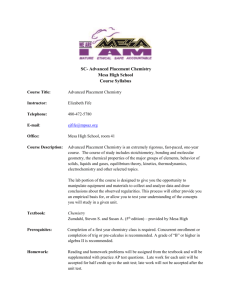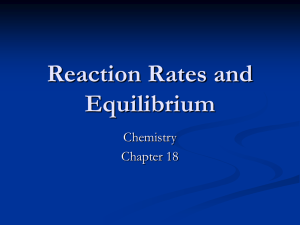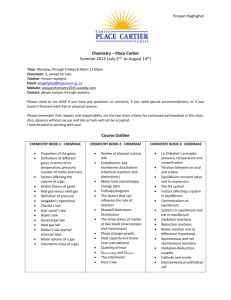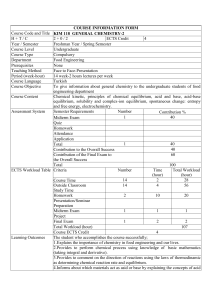General Chemistry II and Lab - Arkansas Northeastern College
advertisement
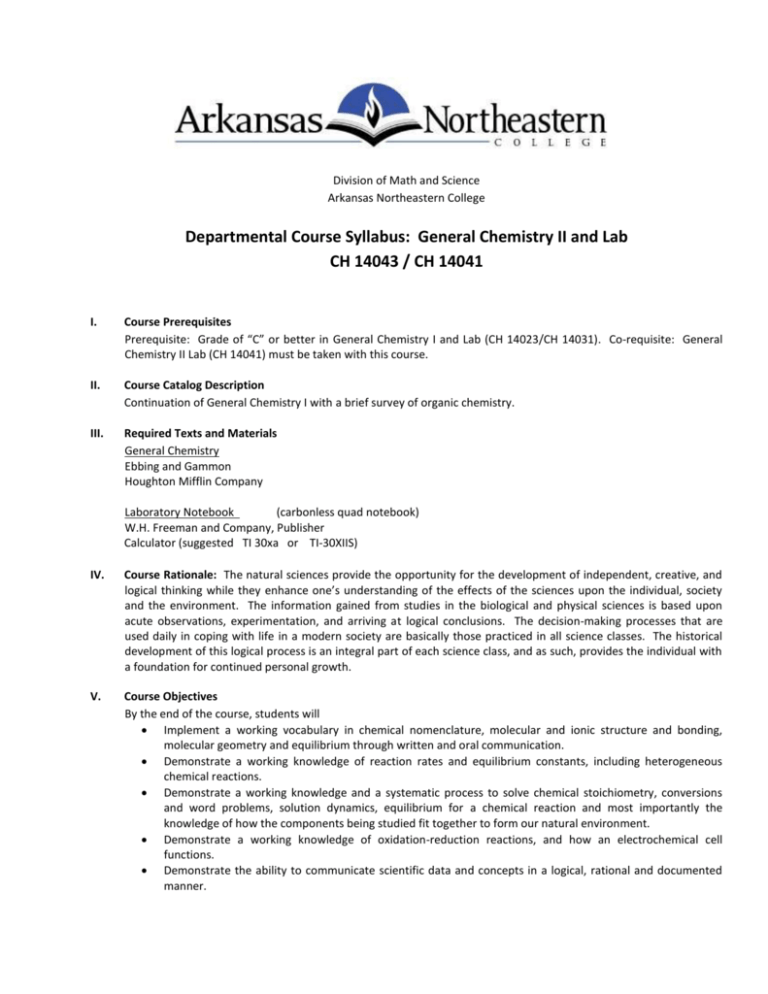
Division of Math and Science Arkansas Northeastern College Departmental Course Syllabus: General Chemistry II and Lab CH 14043 / CH 14041 I. Course Prerequisites Prerequisite: Grade of “C” or better in General Chemistry I and Lab (CH 14023/CH 14031). Co-requisite: General Chemistry II Lab (CH 14041) must be taken with this course. II. Course Catalog Description Continuation of General Chemistry I with a brief survey of organic chemistry. III. Required Texts and Materials General Chemistry Ebbing and Gammon Houghton Mifflin Company Laboratory Notebook (carbonless quad notebook) W.H. Freeman and Company, Publisher Calculator (suggested TI 30xa or TI-30XIIS) IV. Course Rationale: The natural sciences provide the opportunity for the development of independent, creative, and logical thinking while they enhance one’s understanding of the effects of the sciences upon the individual, society and the environment. The information gained from studies in the biological and physical sciences is based upon acute observations, experimentation, and arriving at logical conclusions. The decision-making processes that are used daily in coping with life in a modern society are basically those practiced in all science classes. The historical development of this logical process is an integral part of each science class, and as such, provides the individual with a foundation for continued personal growth. V. Course Objectives By the end of the course, students will Implement a working vocabulary in chemical nomenclature, molecular and ionic structure and bonding, molecular geometry and equilibrium through written and oral communication. Demonstrate a working knowledge of reaction rates and equilibrium constants, including heterogeneous chemical reactions. Demonstrate a working knowledge and a systematic process to solve chemical stoichiometry, conversions and word problems, solution dynamics, equilibrium for a chemical reaction and most importantly the knowledge of how the components being studied fit together to form our natural environment. Demonstrate a working knowledge of oxidation-reduction reactions, and how an electrochemical cell functions. Demonstrate the ability to communicate scientific data and concepts in a logical, rational and documented manner. VI. Unit and Instructional Objectives Lecture Topical/Unit Objectives: I. Unit One Rationale: Solid, liquid or gas – this is the physical world in which we live. To understand, interpret and control our environment, one must be familiar with the phases of matter and the rules which govern those phases. Many reactions occur in water and solutions are integral to every aspect of life, knowledge and education. In order to understand and control chemical reactions, knowledge of solutions and their colligative properties is essential. Objectives: The student will be able to: A. States of Matter: Liquids and Solids 1. Explain and calculate the heat required for a phase change of a given mass of substance. 2. Calculate vapor pressures and heats of vaporization of a substance, given the mass. 3. Define ‘critical temperature’. 4. Given a word problem, relate the conditions for the liquefaction of gases to the critical temperature. 5. Describe and explain a phase diagram. 6. Given the molecular structure, state the kinds of intermolecular forces expected for a substance. 7. Given two liquids, decide on the basis of intermolecular forces which has the higher vapor pressure at a given temperature or which has the lower boiling point. 8. Identify types of solids from the types of bonding. 9. From structure and bonding, predict relative melting points of solid substances. B. Solutions 1. Define and contrast: suspension, colloid and solution. 2. Define and explain: solution, solvent, solute and colligative properties. 3. Discuss the distinctions between saturated, unsaturated and supersaturated solutions. 4. Describe the concentration of a solution in units of: molality, molarity, % by mass, % by volume, and parts per million. 5. Define ‘mole fraction’. 6. Calculate boiling point elevation and freezing point depression 7. Given a word problem, use Henry’s law to calculate the solubility of a gas in a solvent. 8. Calculate molecular weights given the masses of solvent and solute and the molality of a solution. II. Unit Two Rationale: The completion of a chemical reaction is a time sensitive process. The study of the rate, or speed, of a reaction is important – ‘will this reaction take three days or will it go to completion so fast an explosion will occur?’ In terms of safety, the understanding of reaction rates is paramount. Industrially, medically, and in general, the knowledge of reaction rates is fundamental to the production of goods and services involving chemical reactions. At the most elementary level, the understanding of a reaction rate is, simply, the understanding of how a chemical reaction occurs. Objectives: The student will be able to: A. Rates of Reaction and Reaction Mechanisms 1. Define ‘kinetics’. 2. Given a balanced equation, supply different possible ways of defining the rate of the reaction. 3. Given the concentrations of reactant or product at different times, calculate the average and instantaneous rate of reaction. 4. Demonstrate a working knowledge of the various conditions that affect reaction rate (concentrations, temperature, catalysts, etc). 5. Discuss what is meant by the ‘order’ of the reactant or product. 6. Describe a first order reaction, and give example. 7. Describe and use the relationships between reactant concentration and time for zero-order, first-order, and second-order reactions. 8. Relate the half-life of a reaction to the rate constant. 9. Given a chemical reaction, utilize collision theory to describe the effect of reactant concentration on reaction rate. 10. Discuss and utilize the Arrhenius equation. III. Unit Three Rationale: Chemical reactions are dynamic. In fact, very few start with reactant A and reactant B, react, and end with completely new compounds with none of the starting material left over. More likely, a chemical reaction reaches an equilibrium, wherein there is a mixture of reactants and products present. The ability to identify this equilibrium, and possibly even control it, is necessary for safe and productive chemical processes. Objectives: The student will be able to: A. Chemical Equilibrium 1. Given the concentrations of substances in a reaction mixture, predict the direction of the reaction. 2. Given a chemical equation, write the equilibrium constant expression, Kc. 3. Discuss why the concentrations of solids and pure liquids are not included in equilibrium constant expressions. 4. Obtain one equilibrium concentration given the others, and given the starting composition and Kc of a reaction, calculate the equilibrium composition. 5. Discuss Le Chatelier’s principle, and apply in terms of adding or removing one of the components of a reaction. 6. Apply Le Chatelier’s principle to predict the effect of a disturbance on chemical equilibria, including temperature changes, pressure and volume changes with reactions involving gases. 7. Explain how a catalyst is involved in a reaction. B. Acids and Bases 1. Discuss and contrast: Bronstead-Lowry and Lewis concept of acids and bases. 2. Given an acid-base reaction and the relative strengths of acids or bases, decide whether reactants or products are favored. 3. Discuss the self-ionization of water. 4. Discuss the concept of pH and pOH, and how this relates to the Kw. 5. Given the hydrogen ion concentration, calculate pH and pOH. C. Acid-Base Equilibria 1. Discuss: Ka and Kb and solution pH. 2. Given either a monoprotic or polyprotic acid, discuss Ka, hydronium ion concentration, and solution pH. 3. Determine whether an aqueous solution of a given salt is acidic, basic or neutral. 4. Calculate the common-ion effect on acid ionization. 5. Discuss buffers, and how they influence a solution. 6. Discuss titration curves, and how the pH of a solution is related. D. Solubility and Complex-ion Equilibria 1. Write the solubility product expression for a given ionic compound. 2. Calculate Ksp from the solubility or vice versa. 3. Calculate the solubility of a slightly soluble salt in a solution of a common ion. 4. Predict whether a precipitation will occur given the concentrations of ions originally in solution. 5. Calculate the concentration of a metal ion in equilibrium with a complex ion. IV. Unit Four Rationale: In order to determine whether a reaction will occur ‘as written’, both thermodynamics and equilibria need to be considered. The marriage of these concepts, along with the concepts covered in General Chemistry I and General Chemistry II, provides a higher level understanding of chemical processes. This provides a foundation on which many other layers of knowledge may be built, including higher level chemistry, physics and industrial processes. Objectives: The student will be able to: A. Thermodynamics and Equilibrium 1. Describe the difference between kinetic information and thermodynamic information about a chemical reaction. 2. Discuss the first law of thermodynamics and how this relates to enthalpy. 3. Discuss the second law of thermo, entropy, and calculate entropy change for a phase transition. 4. Predict the sign of the entropy change in a given reaction. 5. Calculate the entropy of a reaction given the standard entropies of reactants and products 6. Discuss Gibbs free energy, enthalpys of formation and entropy. 7. For a given reaction, calculate enthalpy, entropy and free energy, and determine the spontaneity of a reaction. 8. Relate free energy to the equilibrium constant, and apply mathematically for a given chemical reaction. B. Electrochemistry 1. Balance redox equations in acidic and basic solutions by the half reaction method. 2. Discuss the voltaic cell, sketch and label, and determine electron flow. 3. Write the cell reaction from cell notation for a voltaic cell. 4. Discuss the meaning and significance of ‘emf’. 5. Relate equilibrium constants and emf’s C. Organic Chemistry 1. Given a compound, classify as organic or inorganic. 2. Given simple organic compounds, draw the appropriate structure. 3. Identify structural isomers and stereoisomers. 4. Discuss and identify the structures of fats and oils and their properties. 5. Given an organic compound, identify functional groups (alcohols, amines, carboxylic acids, etc). Laboratory: Rationale: The ability to work safely and efficiently in a laboratory setting is essential. The laboratory, taken concurrently with the lecture, illustrates and reinforces the material and principles in General Chemistry II. The skills developed in a controlled laboratory setting, including documentation, computer skills, and chemical handling, will translate into a myriad of settings and prepare the student for further educational and career opportunities. Objectives: The student will be able to: Experiment 1: Lab Safety and Correct Documentation Techniques 1. Locate and utilize all safety equipment in the laboratory. 2. Write a prelab after reading an experimental procedure. 3. Record data in a laboratory notebook in the correct manner, and plan data sheets and post labs. Experiment 2: Calibration Curve – Calibrate Your Thermometer 1. Determine four known temperatures possible to reproduce in lab (water freezing, water boiling, etc), and measure with your thermometer. 2. Using EXCEL, construct a calibration curve of ‘known’ temperatures vs. ‘measured’ temperatures. 3. Determine the equation that will be used to correct any inaccuracies of that particular thermometer. Experiment 3: The Heat Capacity of Metals 1. Utilize a Styrofoam cup calorimeter to determine the heat capacity of a metal. 2. Discuss how molecular motion relates to heat. 3. Using EXCEL, create a macro for calculations. Experiment 4: Vapor Pressure, Enthalpy of Vaporization, and Enthalpy of Fusion of Water 1. Utilize the method of mixtures to determine thermodynamic quantities relating to water. 2. Using EXCEL, create a macro for calculations. Experiment 5: Determination of a Molecular Weight by Freezing Point Depression 1. By utilizing a colligative property of a solution, determine the molecular weight of an unknown substance. 2. Discuss what is meant by ‘colligative property’. Experiment 6: The Rate of an Iodine Clock Reaction 1. Carefully produce solutions of known concentrations, and use proper analytical technique in measuring and mixing solutions. 2. Identify, from data, the role of a catalyst. Experiment 7: Le Chatelier’s Principle 1. Carefully produce solutions of known concentrations, and use proper analytical technique in measuring and mixing solutions. 2. Identify the response of chemical reactions when disturbed (temperature change, reactant/product concentration change). 3. Discuss how this experiment (if it does) illustrates Le Chatelier’s Principle. Experiment 8: An Acid-Base Titration Curve 1. Discuss differences between hydronium ion concentration and total acidity of an acid. 2. Quantitatively recognize the endpoint of an acid-base titration. Experiment 9: Determination of an Equilibrium Constant by Spectrophotometry 1. Correctly use a Spectrophotometer (Spec 20). 2. Construct a calibration curve from known solutions using EXCEL. 3. Determine the equilibrium constant for the formation of a complex. Experiment 10: Ground Water Contamination: Spectrophotometry 1. Correctly use a Spectrophotometer (Spec 20). 2. Construct calibration curves for specific ions from known solutions using EXCEL. 3. Identify the presence and concentration of the specific ions in water samples collected from various locations. Experiment 11: Identification of Metal Ions – Separation Schemes 1. Separate mixtures of chromium (III), Iron (III), and copper (II). 2. From the separation scheme produced, identify which metal ion is in an unknown. Experiment 12: Redox Titrations 1. Set up and correctly use a buret. 2. Use a redox reaction to quantitatively determine the amount of oxidizing agent in an unknown sample. Experiment 13: Electrochemical Cells 1. Set up an electrochemical cell based on two half-reactions. 2. Determine how cell voltages are related to the concentrations of the components of the cell. 3. Calculate equilibrium constant from cell voltages. Experiment 14: Molecular Models of Organic Molecules 1. Produce molecular models (Styrofoam balls and bamboo skewers) of alkanes and alkenes. 2. Substitute functional groups in place of hydrogen. 3. Identify any possible isomers. VII. Course Policies: Grades of "Incomplete": The current College policy concerning incomplete grades will be followed in this course. Incomplete grades are given only in situations where unexpected emergencies prevent a student from completing the course and the remaining work can be completed the next semester. Your instructor is the final authority on whether you qualify for an incomplete. Incomplete work must be finished by mid-term of the subsequent semester or the “I” will automatically be recorded as an “F” on your transcript. Technology and Media Email: Arkansas Northeastern College has partnered with Google to host email addresses for ANC students. myANCmail accounts are created for each student enrolled in the current semester and is the email address your instructor will use to communicate with you. Access your email account by going to http://mail.google.com/a/smail.anc.edu and using your first and last names, separated by a period for your username. Your default password is the last six digits of your Student ID. If you cannot access your student email, contact the MITS department at 762-1020 ext 1150 or ext 1207 or send an email to ANChelp@smail.anc.edu. Internet: This course has a web component on myANC. Student Expectations Disability Access: Arkansas Northeastern College is committed to providing reasonable accommodations for all persons with disabilities. This First Day Handout is available in alternate formats upon request. Students with disabilities who need accommodations in this course must contact the instructor at the beginning of the semester to discuss needed accommodations. No accommodations will be provided until the student has met with the instructor to request accommodations. Students who need accommodations must be registered with Johnny Moore in Statehouse Hall, 762-3180. Professionalism Policy: Per classroom etiquette: mobile phones, iPods, etc. must be silenced during all classroom and lab lectures. Those not heeding this rule will be asked to leave the classroom immediately so as to not disrupt the learning environment. Please arrive on time for all class meetings. If you know ahead of time that you will be late, please contact the instructor ahead of time and provide that information. If a student is late for a lecture, I have no problem with entering the class as long as it is done in a professional manner (no noise, no talking, etc). NO TEXTING IN CLASS. Academic Integrity Policy: Academic dishonesty in any form will not be tolerated. If you are uncertain as to what constitutes academic dishonesty, please consult ANC’s Student Handbook (http://www.anc.edu/docs/anc_handbook.pdf) for further details. Students are expected to do their own work. Plagiarism, using the words of others without express permission or proper citation, will not be tolerated. Any cheating (giving or receiving) or other dishonest activity will, at a minimum, result in a zero on that test or assignment and may be referred, at the discretion of the instructor, to the Department Chair and/or Vice President of Instruction for further action. VIII. Assessment Any tools for institutional assessment will be provided by the Chemistry Department. Calculation of the final grade will be determined by the following: Assessment Lecture – exams/quizzes/assignments Final Exam Laboratory Final grades will be assigned according to the following: Grading Scale (%) 90-100 80 – 89 70 – 79 60 – 69 0 – 59 Percent of Final Grade 55% 20% 25% 100% A B C D F


